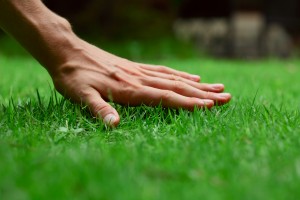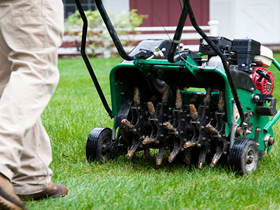Aeration
 VIRIDIS Lawn Care is excited to announce we will now begin lawn aeration. This vital process will breathe new life into your lawn and help you maintain the healthy, lush lawn you always wanted.
VIRIDIS Lawn Care is excited to announce we will now begin lawn aeration. This vital process will breathe new life into your lawn and help you maintain the healthy, lush lawn you always wanted.
Lawn aeration can improve air and water circulation to grass’ root system, improving the overall health of your lawn. Most lawns will need this done at least once. Extra thick lawns, especially those started from sod rather than seed, may need aerated more than once.
During aeration, a machine called a core aerator is used to remove about 4 inch plugs of thatch, dirt, and even some roots. Allowing these to disintegrate into the lawn is recommended as the pugs provide needed nutrients. This will leave little holes throughout the lawn, which are then able to receive needed air, water, fertilizer, and herbicides and distribute them throughout the root system. This is also a great way to reduce thatch buildup and help reduce soil compaction which can make it difficult for the roots to grow.
Fall and spring are the best times to aerate. Lawns are most used during the summer months, causing more soil compaction as they are walked on, played on, and barbequed on. Fall aerating helps to undo this so the grass can go through the winter healthier. Winter also takes a toll on lawns. Extra moisture can cause compaction also, especially in clay soils. Heavy snow falls and long cold spells or slow springs can make it harder for grass roots to “get going” when warm weather does come. Spring aerating helps to increase the air and water intake to these roots, making it easier for them to produce green in the spring.
Aerating your lawn may not seem like a priority but it is a simple step that can considerably increase the health and beauty of your landscape. Allow VIRIDIS Lawn Care in Salt Lake City to serve your aerating needs.
Thatch is the portion of grass between the roots and the green tops. It is made up of dead grass, leaves and other small particles that provide nutrients as it decomposes and can protect against extreme temeratures. It also can help decrease compaction and increase water intake. While some thatch is important and helpful in a healthy lawn, over ½ inch of thatch buildup can be detrimental by blocking air and water intake. It can also cause the roots to begin growing in the thatch area rather than underground. Insects and diseases can spread in this area and it can even choke out healthy grass over time. Thatch growth is increased by overwatering, planting lawns in heavy clay soils, over fertilizing and mowing grass too high.
In order to restore the health to a heavily thatched lawn, dethatching is necessary. It involves either power raking or hand raking, depending on the amount of exercise you want to get and the area you have to dethatch, to remove some of this buildup. It is best done during spring or fall after either a rain or a watering. Mow grass shorter than normal, around 1 inch high, and remove clippings. Then run either your rake or power rake over the area and remove the debris that results. A power rake is much more efficient and effective but either method will help. If thatch buildup is severe, over 1 ½ inches, allow the lawn to recover after dethatching and then repeat again in a few weeks so as not to harm the lawn more than help it.
At VIRIDIS Lawn Care of Salt Lake City, Utah, we want to help you have the best lawn in your area. Dethatching is just one way to restore some vigor to a tired looking lawn and help it regain some health and beauty.





